You probably know them by their large yellow eyes and fluffy appearance, but the great horned owl (GHOW) is a fascinating bird of prey in many other ways. These owls have earned themselves the nickname “Tigers of the Woods” and are top-notch silent assassins (Audubon). Located in secondary-growth woodlands, swamps, orchards, and deciduous, coniferous or mixed forests, they can be hard to spot. They usually reside along the edges of open grassland, pastures, and of course, forests (Cornell University: All About Birds). Their mixed plumage coloration and ear tufts help them blend in very well to the surrounding environment. So keep your eyes open for a dark lump on a branch (you can’t miss their yellow eyes)!
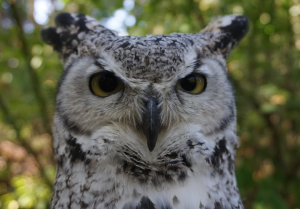 Arktos (top) and Danny (bottom) GHOWs from The Raptors in Duncan BC. Photographed by: Christina
Arktos (top) and Danny (bottom) GHOWs from The Raptors in Duncan BC. Photographed by: Christina 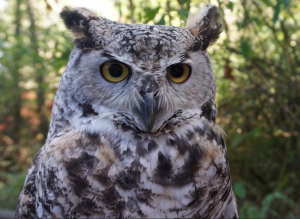 Youngren
Youngren
One key characteristic of great horned owls is, well, their horns! Rather, they are purely feathers used for camouflage (breaks up silhouette) and communication (raising/lowering crown feathers). On Vancouver Island, our resident GHOW’s coloration is reddish brown/white/black, while on the northern mainland it can vary to white/grey/black (Cornell University: All About Birds). We know their eyes are stunning, but there are pros and cons to having them! Owls have many rod photoreceptors (low level vision) and little cone receptors (daylight colour) in their eyes. The result is that these diurnal birds can hunt effectively at night. Their eyes are actually tube-like, and are fixed in their sockets. This means the owl can’t “cross his eyes”, but has high-level distance vision (Jones M.P., Pierce Jr K.E., Ward D.). An owl’s eyes take up ~70% of its skull! Not being able to cross your eyes means you can’t focus on objects up close. To fix this issue, GHOW’s have specialized whisker-like feathers on their face called “filoplumes” to help sense things in close proximity. This leads to the shape of an owl’s face. Special feathers form a facial disk that focuses sound in and acts as a satellite dish. Asymmetric ears on the side of the head make hearing almost 3-D-like. One is down and facing back, the other is up and facing forward (Konishi M., 2012).
Showing the plumage variation: Arktos (left) and Danny (center), GHOW’s at The Raptors in Duncan BC. Photographed by: Christina Youngren. (right) https://www.pinterest.ca/explore/raptor-center/
Specialized facial feathers: Arktos, GHOW from The Raptors. Photographed by: Christina Youngren
As far as conservation status goes, the GHOW is of least concern according to the International Union for Conservation of Nature (IUCN). Although their overall population is on the decline (33% between 1966 and 2015), they still have a sustainable number to be a successful species. Northern populations fluctuate with predator-prey relationships (IUCN). Owls prey on many mammals (mice, shrews, rabbits, etc.) and other bird species, which can be contaminated with pesticides and poison. These accumulate in the owl and can lead to death (Cornell University: All About Birds). This is still an unfortunate common occurrence today.
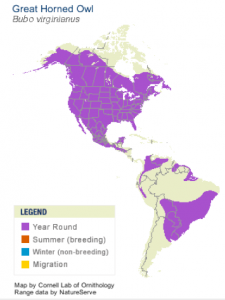 As you can see from the range map above, great horned owls are quite common in the Americas and can be seen year round.
As you can see from the range map above, great horned owls are quite common in the Americas and can be seen year round.
Owls are true raptors, and we know this because they have a downward curved beak for ripping and tearing flesh, sharp talons and great eyesight. As you probably already know, owls have silent flight. This is due to the comb-like serrations on the leading edge of the wing feathers (Audubon). The great horned owl use this as their secret weapon of assassination, but as I mentioned above, their eyesight is also a major contributor to their hunting success. A funny fact about owls is that they can actually dance…. the owl dance! This dance is more scientifically explained as them shifting their eye focus on different objects and depths. See for yourself!
Great horned owls are usually solitary birds and territorial, but when it’s mating season they find a mate and stay monogamous, fending the territory together as a pair. They usually take over old nests left by squirrels or other owls. Breeding season is between November and April. During this time owls lay an average number of 3 eggs per year, which they incubate for 30-37 days. Once the young ones are 8-10 month old, the parents will “kick them out of the nest” to go fend for themselves and eventually find their own mates (BioKIDS).
Great horned owls are wonderful to behold. Their looks, anatomy and behaviours continue to amaze us. I hope you get a chance to come across these incredible raptors in their natural habitat. Keep your eyes skyward!
Literature Cited
1) Audubon Guide to North American Birds (Internet). [Cited 2017, September 22]. Available from: http://www.audubon.org/field-guide/bird/great-horned-owl
2) Cornell University: All About Birds (Internet). Great Horned Owl. [Cited 2017, September 22]. Available from: https://www.allaboutbirds.org/guide/Great_Horned_Owl/lifehistory
3) Jones M.P., Pierce Jr K.E., Ward D. 2007. Avian Vision: A Review of Form and Function with Special Consideration to Birds of Prey. Journal of Exotic Pet Medicine. 16: 69-87. doi: 10.1053/j.jepm.2007.03.012
4) Masakazu M.. 2012. How the Owl Tracks Its Prey. American Scientist. 100: 494-503.
5) The IUCN Red List of Threatened Species (Internet). [Cited 2017, September 23]. Available from: http://www.iucnredlist.org
6) Dietrich D. great Horned Owl. BioKIDS – Kids’ Inquiry of Diverse Species (Internet). [Cited 2017, Sept 25]. Available from: https://www.biokids.umich.edu/critters/Bubo_virginianus/
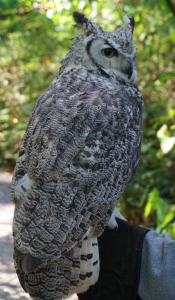
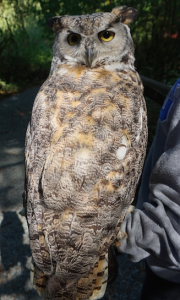
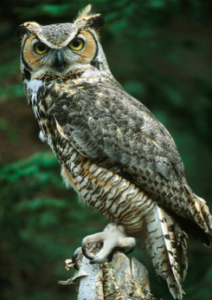
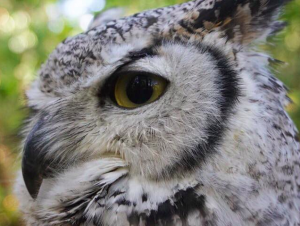
Very neat! I had no idea how far ranging they are! I was wondering, do you know if the owls are monogamous for life or for a specific breeding season?
Yeah I didn’t know they ranged as far south as South America! And it is believed that they stay monogamous for many breeding seasons!
I love the dancing video! LOL
These are a handsome species. Very cool seeing one with you in its own habitat at Somenos Marsh!
Yeah! I wish I brought my camera to get a photo for the blog.
I love the pictures that you took! It`s so cool that you get to see them so up close. I was wondering how often do they do their dance? and is it usually done before hunting?
^^^ its Catherine I don’t know why it showed my student #
Thanks! We will be seeing Arktos and/or Danny on the field trip this week 🙂 The dance can be done for a few reasons. Hunting is one, as they visually pin-point moving prey. They do it if they are being vigilant and interested in something, whatever catches their eye. I did not come across any studies that indicated how frequently they dance, but I think it is dependant on the level activity the day brings for them!
Nice blog. These guys are crafty. Check this video, of a GHOW that gets a heron off its nest so it can eat the young. https://youtu.be/v7w7ERBQvfs?t=30s
Not for the faint of heart if you like heron kids.